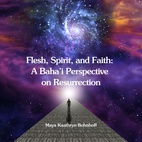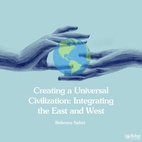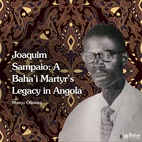The views expressed in our content reflect individual perspectives and do not represent the authoritative views of the Baha'i Faith.
Every marriage begins in hope, but inevitably, it seems, even hopeful unions can end. That’s why, for Baha’is, the process of ending a marriage is meant to restore hope and spiritual peace of mind.
The Baha’i teachings encourage marriage and discourage but permit divorce. A Baha’i divorce can only take place after a “year of waiting” – a one-year period of attempted reconciliation, reflection, and the resumption of dignity. Abdu’l-Baha, the son and successor of Baha’u’llah, the prophet and founder of the Baha’i Faith, summarized this unique Baha’i “year of waiting” law:
They must strictly refrain from divorce unless something ariseth which compelleth them to separate because of their aversion for each other, in that case with the knowledge of the Spiritual Assembly they may decide to separate. They must then be patient and wait one complete year. If during this year, harmony is not re-established between them, then their divorce may be realized.
RELATED: Marriage: A House is not a Home
It took me more than two years after the completion of my Baha’i year of waiting, which ended in January 2018, to write about my experiences and insights from that year, and yet more time to organize them in such a way that I could communicate them effectively to others.
Much like the year of waiting itself, I needed this additional time to reflect and to place some distance between myself and that difficult chapter of my life, giving me the perspective required for discussing what I consider to be an underappreciated law of Baha’u’llah.
For those unfamiliar with this unique Baha’i law, let me briefly explain. Marriage in the Baha’i Faith is given a high station, extolled by Baha’u’llah as “a fortress for well-being and salvation.” The family is not just the atomic unit and bedrock of Baha’i community life, it is described in the Baha’i teachings as an actual institution of the Faith. The unity of the family is of paramount importance, so much so that a Baha’i’s service to the Faith and to humanity must be subordinated to it. After all, if our families are not united, how can Baha’is work toward building united communities, let alone a united world?
Naturally in a Faith whose central tenet is the unity of humankind, divorce — which is so often marred by contention and estrangement — is strongly discouraged; it is allowed only after the married couple enter into a “year of waiting” during which they physically separate, attempt to reconcile their differences, and ideally, rekindle the flame of love and affection between them. This period, also sometimes known as a “year of patience,” need not last an entire year; if the couple manages to reach agreement and reconcile sooner, it ends then and there. If reconciliation remains elusive after the passing of a full year, the couple may then divorce.
The Baha’i teachings set forth some essential rules for this period of time: an elected Baha’i administrative institution must approve the year of waiting and fix its starting date after conferring and consulting with the couple; the couple must physically live in separate dwellings and refrain from having marital relations; neither may date — or indeed seek to date — other people; they each need to make a sincere effort at reconciling the marriage; and unless circumstances require otherwise, the husband remains responsible for the financial support of the family.
Divorce: A Last Resort
For a Baha’i couple, applying for the year of waiting is an act of last resort in a marriage. All marriages experience difficulties at some point, and couples are encouraged to seek marriage counseling as soon as conflicts arise that they cannot themselves resolve. Baha’i couples may also seek spiritual guidance from their Local Spiritual Assembly, or ask that institution to adjudicate some specific disagreement.
In each locality where a Baha’i community exists, the believers annually elect a nine-person leadership body called a Local Spiritual Assembly. Since the Baha’i Faith has no clergy, this democratically-elected group of people guides and supports the community and counsels and helps the individual Baha’is within it. Because Baha’is elect their Local Spiritual Assemblies – and the National Spiritual Assemblies in each country, as well as the Universal House of Justice for the entire global Baha’i community – without electioneering, nominations, or campaigning, the process produces administrative bodies designed to offer and give able assistance to those who need it.
In reality, however, within the Baha’i community as well as outside it, couples with troubled marriages all too often seek counseling as a last-ditch attempt to save an already failing union, rather than as a natural part of a couple’s growth and learning about each other. And when counseling fails at this late stage, as it often does, the only avenue remaining for Baha’is is to request a year of waiting.
As someone who has served on a Local Spiritual Assembly for nearly two decades, I have seen my share of couples go through a year of waiting, yet only a few of these cases resulted in reconciliation. Long before my own marriage began to fall apart I wondered about this, and whenever a new request for a year of waiting came before the Assembly, one thing became increasingly clear to me: most married couples delay far too long in seeking their Assembly’s guidance and counsel when difficulties arise in their marriage, and when things get even worse they procrastinate far too long to initiate and begin a year of waiting. By the time many of these couples approached the Assembly on which I served, their marriage was not only in serious trouble, they were already emotionally divorced. I suspect that there is a time window during which the year of waiting can be effective, and that they had missed it.
How could this happen? Perhaps they were unwilling to admit failure, or worried about how a temporary separation might be viewed by their family or their community, or afraid that taking that first step would begin an irreversible process ending in divorce. But therein lies the issue: Baha’u’llah did not reveal this new law merely as a hoop to jump through to make it harder to end a marriage. Instead, he wrote in his Most Holy Book:
Observe My commandments, for the love of My beauty. Think not that We have revealed unto you a mere code of laws. Nay, rather, We have unsealed the choice Wine with the fingers of might and power. … Meditate upon this, O men of insight!
The Universal House of Justice has clarified that when the believers’ understanding of and devotion to the Baha’i laws is increased, “they will obey them not through fear of punishment but out of love for Baha’u’llah and because their whole lives have been transformed and re-oriented in the Way of God.” When we examine the law of the year of waiting in this light, we can conclude that Baha’u’llah intended for couples to avail themselves of it well before their differences become irreconcilable. I’m not advocating for anyone to do so at the first sign of significant trouble in a marriage; that’s what marriage counseling is for. However, the term “last resort” does imply that all hope for reconciliation is not lost.
So where is the line? When is the right moment in the decline of a marital relationship to apply for a year of waiting? Of course this question cannot be addressed in general terms; every situation is unique. It requires consultation (insofar as the couple is capable of it), and in any event a lot of ardent soul-searching and prayer. But perhaps one criterion a couple could use is that they have given up on finding a solution themselves, yet they remain open to a solution should one present itself — that point in their relationship where they might say, “We’re out of ideas, but perhaps the Baha’i teachings can help us.”
When my own previous marriage reached this stage, I explained it to my adult children with an analogy: the marriage is like a cardiac arrest patient, and the year of waiting is the defibrillator; the patient is in critical condition, but there is a chance of survival as long as swift and decisive action is taken.
RELATED: Sex, Marriage and Real Freedom
What Is Reconciliation?
A defibrillator sends a powerful electric shock through the heart in an attempt to restart it. Similarly, when one of the spouses moves out of the home it delivers a severe shock to the relationship. When a Baha’i year of waiting commences, this shock impels both spouses to reflect deeply on what the marriage means to them, and what they are willing to do in order to save it.
Just as someone who suffers a heart attack cannot go back to living life in exactly the same way as before — significant changes in diet and lifestyle will be required to prevent a recurrence — so it is with a marriage during and after the year of waiting. If the couple does decide to reconcile, they cannot simply go back to the way things were; whatever caused the conflict that threatened the life of the marriage must be rooted out, even as Baha’u’llah said in another context, “Gather ye together, and for the sake of God resolve to root out whatever is the source of contention amongst you.”

Reconciliation is not a mere decision to forget about differences; quite the contrary, it involves a painstaking process of analyzing and laying bare the root causes of conflict. It involves listening, learning, adjusting, and finding ways to harmonize differing views and perspectives. Under ideal circumstances, this process of reconciliation is continually happening throughout the marriage, but a lack of communication or loss of emotional connection can block this natural process and create what may seem like an insurmountable obstacle.
The desired outcome of the Baha’i year of waiting is not that the couple magically “kiss and make up,” but rather that they restart the flow of communication between them and clear their “reconciliation backlog” in an intensive yet controlled manner. When, God willing, they emerge from this difficult period having reconciled their differences and restored the affection between them, they cannot look back; they must move forward on the basis of the new understanding created between them, and with renewed commitment to keep lines of communication open and healthy.
















Comments
Sign in or create an account
Continue with Googleor